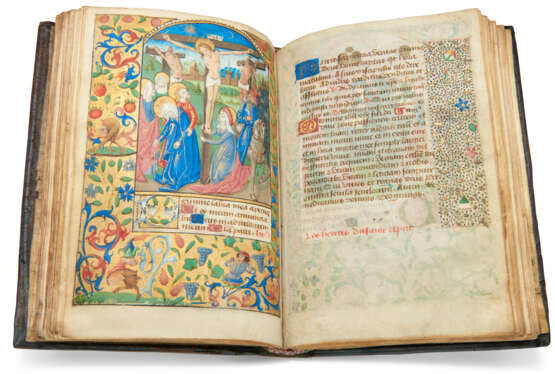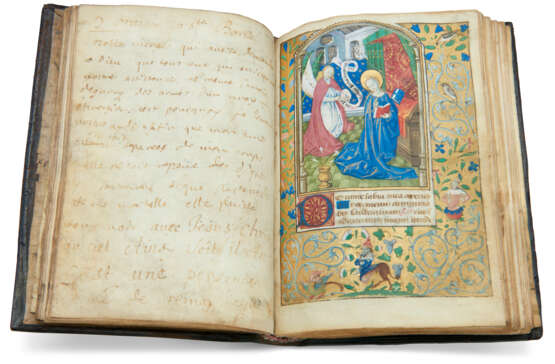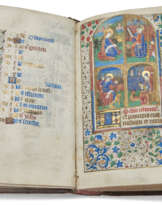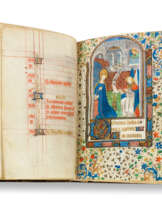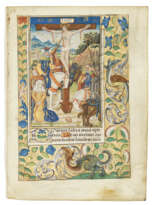ID 993227
Lot 57 | Master of the Rouen Échevinage (active 1460s-80s)
Estimate value
£ 20 000 – 30 000
Book of Hours, use of Poitiers, in Latin and French, illuminated manuscript on vellum [Rouen, c.1485]
A book for Poitiers by the leading illuminator of Rouen: an accomplished late work by the Master of the Rouen Échevinage.
158 x 110mm, ii + 65 leaves, modern foliation 1-67, including i-ii, followed here: 1-26, 3-48, 5-106, 111(of 2, lacking i, probably cancelled blank), vertical catchwords, text apparently complete, 24 lines, written space: 93/96 x 64mm, two- and one-line initials and line endings alternately in liquid gold on maroon or ?silver on blue, a border in the outer vertical margin of every written page, 13 large miniatures within full borders of sprays of acanthus, fruit and flowers inhabited by birds, animals and grotesques on grounds of liquid gold (slight wear to miniatures and their borders, more extensive to miniatures ff.30v and 67, some text borders rubbed, smudging from erasure of added shield f.30, some offsetting from initials and miniatures; occasional staining and smudging, small hole below added tact on blank f.66). 16th-century brown calf over pasteboard tooled in blind with a central strapwork cross motif within an oval framed by two sets of double fillets, spine in six compartments tooled in blind (some wear). Half-morocco box by James Brockman.
Provenance:
(1) The Office of the Virgin is for the use of Poitiers; the litany includes St Radegunde, whose cult centred on Ste-Croix, the abbey she founded outside Poitiers. The original sparse Calendar in French was localised by the addition in Latin, with no red, of saints familiar in Western France with a focus on those specially revered either in Poitiers, e.g. Hilary, Bishop of Poitiers (13 Jan.), the translation of the relics of St Rigomer to Poitou (6 March), St Macrina (6 July), St Generosus (16 July), Radegunde (13 Aug.), Benedict, Bishop of Poitiers (23 Oct.), or in Saintes, e.g. the Bishops Leon (19 March), Vivianus (28 Aug.) with octave, Leodegar (12 Nov.) and the translation of Eutropius (14 Oct.); Eutropius’s main feast on 30 April was included in the original calendar. The alterations to the Calendar suggest that the book was written, as well as illuminated, in Rouen where only inadequate models for Poitiers Use could be found. The interest in St Barbara, evidenced by the miniature, was maintained with the addition of further prayers in her honour.
(2) The name Sauineau (?for Savineau) has been written on the blank f.14; an added quartered shield on f.28 has been erased; the name Bareau is scribbled on the final pastedown.
(3) Sold at Christie's, 28 June 1995, lot 17.
Content: Stabat mater added ff.1-2; Calendar in French with very early additions in Latin ff.3-8v; Gospel Sequences ff.9-11v, Obsecro te in the masculine ff.11v-13; blank with added prayer f.13v; blank with doodled grotesque and pen trials f.14, blank with added French prayer to St Barbara f.14v; Office of the Virgin, use of Poitiers, interspersed from the end of Lauds with the Hours of the Cross and of the Holy Ghost ff.15-41: matins f.15 with the lessons from the Roman use added at end f.19v, lauds f.20, prime f.27v, terce f.30v, sext f.33, none f.35, vespers f.37, compline f.39v; Penitential Psalms and Litany ff.41v-50; Office of the Dead, use of Rome ff.50v-64v; memorials to Sts Catherine and Margaret ff.64v-65; added French verse prayer to St Barbara ff.65-66; memorial to St Barbara f.67.
Illumination:
The miniatures and their borders, despite some wear, are fine examples of the late style of the Master of the Rouen Échevinage (also known as the Master of the Geneva Latini), named for the splendid secular manuscripts he painted for the public library assembled by the aldermen of Rouen. His career, which began c.1460 and spanned about three decades, made him the dominant illuminator in Rouen, at a time of burgeoning book production in manuscript and then print. His colourful and accessible style, with its clearly delineated forms, was comparatively easy to imitate and he seems to have worked with assistants and collaborators to meet the great demand for his work in Normandy and beyond. In addition to this manuscript for a Poitiers patron, where an assistant may have provided elements like the stockier figure of David, f.41v, he was responsible for miniatures in Books of Hours for the Use of Tours (Paris, BnF, ms lat.18030) and the Use of Bourges (Durham, Ushaw College, ms 20). For the Master and his work, see F. Avril and N. Reynaud, Les Manuscrits à Peintures en France 1440-1520, pp.169, 171-173.
The Poitiers Hours shows the Master varying many of his characteristic compositional patterns, deploying his elegantly elongated figures in architectural settings with patterned cloth hangings or landscapes articulated by his hallmark triangular or spherical trees. By the date of this Hours, his palette had become more restrained and the flesh painting of his figures more carefully modelled, as seen in his work in the Breviary of Charles de Neufchâtel, Archbishop of Besançon, datable between 1480 and 1498 and with similar beguiling miniature borders (Besançon, BM ms 69, e.g. p.632; for a variant of St Barbara in an assistant’s hand, p.355). Unlike the coherent Poitiers Hours, but like several of his later productions, the Breviary shows the Master collaborating with illuminators working in completely independent styles.
The Breviary with its classicising architecture and later costume probably dates towards 1490; closer to the Poitiers Hours in date is a copy of Pierre Choisnet’s Le Livre des trois âges de l'homme of c.1483-1484 (BnF, Smith-Lesouëf 70). There the famous hunting miniature on f.5 relates closely to the striking miniature of the Three Living and Three Dead, f.50v, which apparently owes its composition to the Parisian illuminator Maître François (?François le Barbier), as seen in the Wharncliffe Hours c.1475-1480 (Melbourne, National Gallery of Victoria, Ms Felton 1 (1072/3) f.78). The rubric to the Office of the Dead in the Poitiers Hours, In agendis mortuorum, is rare in manuscript but more common in print; the influence of printed books is also evident in the text layout, supporting a date in the mid-1480s between the Livre des trois âges and the Breviary; all three have similar text initials on simple rectangular grounds, although only the Hours has the tarnished silver alternating with gold.
The Rouen Master’s connections with Maître François and Parisian illuminators, as with Netherlandish painting – see the midwife at the Nativity, f.27v, are easily explained by Rouen’s place as one of the great trading centres. The Poitiers Hours, with its links to printed Hours, embodies not only the accomplished late style of the Master of the Rouen Échevinage but also his key role in a city of artistic interchange, where technical innovations were successfully accommodated and exploited.
The subjects of the miniatures are: Annunciation f.15, Visitation f.20, Crucifixion f.25v, Pentecost f.26v, Nativity f.27v, Annunciation to the Shepherds f.30v, Adoration of the Magi f.33, Presentation in the Temple f. 35, Flight into Egypt with the Miracle of the Corn f.37, Coronation of the Virgin f.39v, the penitent David f.41v, the Three Living and the Three Dead meeting outside a church f.50v, execution of St Barbara f.67.
Special notice
No VAT is payable on the hammer price or the buyer's premium for this lot. Please see the VAT Symbols and Explanation section of the Conditions of Sale for further information
| Artist: | Master of the Rouen Échevinage (XV century) |
|---|---|
| Place of origin: | Western Europe, France, Europe |
| Auction house category: | Medieval & renaissance manuscripts |
| Artist: | Master of the Rouen Échevinage (XV century) |
|---|---|
| Place of origin: | Western Europe, France, Europe |
| Auction house category: | Medieval & renaissance manuscripts |
| Address of auction |
CHRISTIE'S 8 King Street, St. James's SW1Y 6QT London United Kingdom | |
|---|---|---|
| Preview |
| |
| Phone | +44 (0)20 7839 9060 | |
| Buyer Premium | see on Website | |
| Conditions of purchase | Conditions of purchase |

